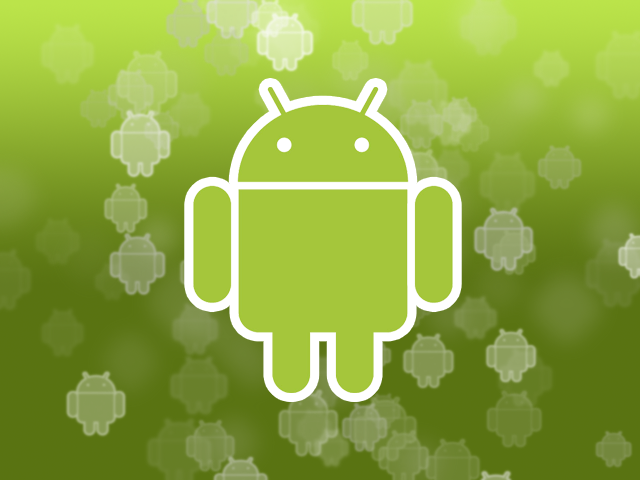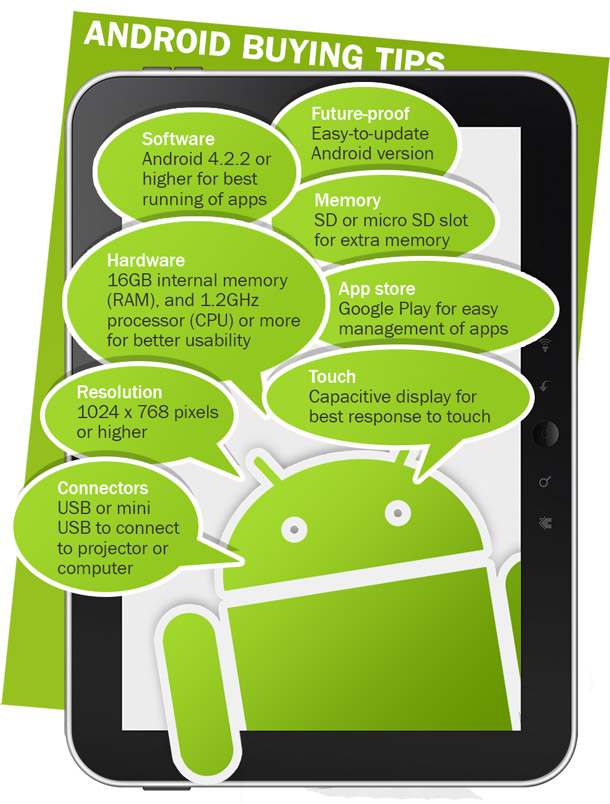
Matt Steele, a specialist digital publishing consultant, looks at the use of Android tablets in the classroom and gives his tips on what to look for when purchasing devices.
There are now Android apps available that add real value to any ELT classroom, from pronunciation apps (English File) to dictionaries (Oxford Advanced Learner’s Dictionary), game-based vocabulary apps (Headway Phrase-a-Day), Graded Readers (Bookworms), and last but not least, complete coursebooks and Readers as e-books via the Oxord Learner’s Bookshelf app. See all of Oxford’s ELT apps and e-books here.
Many of these offer a distinct edge over paper-based options by virtue of their interactivity, and in particular their use of video and audio.
But which device do you buy? This post concerns itself with Android devices – what to look out for, and what to avoid.
Introduction: What it means to use tablets in the classroom
I’m going to make some assumptions about you based on the fact that you are reading this post:
- You’re prepared at least to entertain the idea of using a tablet device in your classroom
- You’ve done a bit of research into methodology and some of the apps available to you
- You’re aware that the tablet software market is divided roughly into three main competitors: Android, Apple’s iOS, and Microsoft Windows
- You’re thinking of buying an Android tablet
What you may still be in two minds about is who will use the tablet device in the classroom. Will it be you, the teacher, presenting content on the tablet, using the tablet as a lookup device, finding pictures, videos, or collocations to illustrate certain parts of the lesson?
A lot of the discussion around tablet usage in an educational setting assumes the possibility of the teacher and the teacher alone using the device. But why would you do that? Why wouldn’t you simply use a computer connected to a projector and/or an interactive whiteboard?
So, if we can assume that when we are talking about using tablets in the classroom we are talking about everybody in the classroom using tablet devices, then we are forced to the conclusion that, unless we work for a particularly wealthy school or college that can afford to purchase at least one classroom’s worth of devices, then the only realistic scenario for using tablet devices is BYOD, or Bring Your Own Device.
The idea behind BYOD is, broadly speaking, that the student brings their device along to the lecture and uses it to take notes, to view material, online or offline, that the lecturer provides. They might even do interactive exercises or tests that the lecturer might assess via his/her own device during or after the class. This means that a student might turn up with their Android / Windows / Apple smartphone, tablet, or even ‘phablet’ (a phone that is almost tablet sized). What should your policy be in that case? Should you allow, and support, any mobile device at all, with any operating system?
In my view, unless you will be relying solely on Apple technologies for classroom management and monitoring purposes, then you should be all-inclusive in your approach. The only thing that you might insist on would be that your students bring along a device that is practical for reading and writing with, which for me would mean a screen no smaller than 7 inches in width, with a resolution of at least 1024 x 768 pixels.
Overview of the Android tablet market
Android is the single most popular Operating System for smartphones and tablets. The reason for this is twofold: firstly, Android has the backing of almost every hardware manufacturer in the world other than Apple, most notably Samsung; and secondly, it’s owned by Google.
In that sense the Android tablet market is like cable TV: lots of choice but also lots of things to avoid.
The Samsung connection is an important one for educational customers. The Samsung hub is an ever increasing set of educational content and services that is set to rival Apple’s iTunesU.
While Android is owned by Google, it is still open source, so the code is constantly added to by developers not necessarily in Google’s employ. The upshot of this is that any given piece of hardware can run its own version of Android, and its own set of software applications. This means that there is a lot of variety available – some better than others.
Things to think about when thinking about buying an Android device
Android tablet checklist
Here are a few things you should bear in mind when selecting which Android tablet to choose:
 How much should you expect to spend?
How much should you expect to spend?
Android is a free operating system, so the money you spend on an Android tablet is determined by its build quality (especially its screen), the quality of its components (especially its processor), its size (7”, 9”, 10”), and any additional software that the manufacturer includes. For me, the screen size is only of importance with regard to its resolution and how it affects the price of the tablet: bigger screen size means higher price. Because you are either connecting it directly to a projector or mirroring it through the laptop that is itself connected to the projector, the size of the screen is of little importance. The resolution of the screen is important, however, for two reasons:
- A higher screen resolution means more detail and a more attractive interface. Many reasonably priced tablets now come with full HD displays.
- Many websites now check what your screen resolution is when you land on them. Often anything below 1024 x 768 will mean that the website will be shown as a ‘mobile’ site compatible with smartphones, rather than the ‘desktop’ version with more information. For me, this alone was the reason I dropped my Nexus 7 for a tablet with a higher resolution.
An important point to bear in mind is whether or not Google Play is available on the model you want to buy. Many of the cheaper tablets won’t give you access to Google’s app store, because Google require that they pay them for its distribution, which will condemn you to buy apps from no-name app stores with no guarantee of quality.
For a school setting it seems to make sense to focus on the build quality first and foremost. Prices vary enormously, from around £70 for a ‘white box’ tablet (manufactured in huge numbers in China), to the superlative Asus Transformer Pad Infinity currently retailing at £600. For our purposes, however, expect to pay anything from around £120 to £370.
Can you test one out?
If you buy in store, yes. Obviously this would mean you couldn’t purchase online, which is where you will find cheaper examples of the same high street product. Like so many things it’s a trade-off between cost and peace of mind.
Do you want to restrict what students can do / download on the tablet device?
How can you know that your students are doing what they are supposed to be doing when they are bent over their tablet devices? Well, there are ways. It means installing software on students’ machines called Mobile Device Management (MDM). There are a number of MDM software vendors about. Most, if not all, support Android. There is a good comparison site here.
Device Support
This is very important. A lot of the very cheap models will provide you with no resource to upgrade the Android operating system. This will seriously inhibit your tablet’s shelf life, which in turn will mean you have to spend money on new hardware sooner.
Some models worth thinking about:
For around £100
Asus Memo Pad HD 7
This 7” pad has an HD resolution of 1280 x 800 px, which isn’t bad. It has a micro SD slot, and a very useful standard USB port. For around £100 it’s a decent budget tablet.
Lenovo IdeaTab A2107A-H
Again, this is a 7” model. Lenovo is the Russian hardware manufacturer who bought the licence to build IBM’s ThinkPad laptop. The build quality of the IdeaTab is every bit as solid. It has two cameras, which is unusual for a tablet costing just over £100.
For around £200
Google Nexus 7 (2)
This is the second generation Nexus 7. It’s a 7” tablet that compares favourably to the iPad mini. It has a huge screen resolution at 1920 x 1200 px. It also sports an extra camera. Drawbacks, though, are its lack of an HDMI port and an SD card slot, so memory can’t be expanded.
Samsung Galaxy Tab 2 10.1
This has a 10.1” screen and is the descendant of the hugely popular Samsung Galaxy Tab 10.
For around £300
Acer Iconia Tab A200
This is a 10.1” tablet, with 12.5 GB of internal memory, and a micro SD card slot should you want more.


Reblogged this on hungarywolf.
[…] The official global blog for Oxford University Press English Language Teaching. Bringing teachers and other ELT professionals top quality resources, tools, hints and tips, news, ideas, insights and discussions to help further … […]
Overall, not a bad guide. Might I suggest a couple additional tips? If you are going to be buying, please consider getting at least a dual-core processor or better? There are still some really cheap models out there (a la Wal-Mart or nameless Chinese knock-offs) that run single core processors. You would do well to obtain 2GB of RAM. 1GB RAM will run most things, until you get into a processor power-demanding app or two, or you are multitasking between a couple apps. Then your choice of 1GB will be very evident in how slow your tablet becomes. Cheap models sometimes obscure their specs and may even have less than 1GB. It’s only a bargain if you save money and the tablet is fully useful.
Eventually, the manufacturers will not push updates to your device (usually a year out as the newer toys hit the market), so consider rooting your device and getting CyanogenMod’s Android ROM’s. You can usually get the latest several editions of Android through them. Google is now officially allowing CyanogenMod access to the Google Play store, where you previously must have downloaded and installed the Google Play application separate from CyanogenMod.
Finally, access to a cloud storage account (Dropbox, Box, SkyDrive, Google Drive, etc.) or a microSD card slot for memory expansion would be prudent so you can gather support materials and store additional books. You’d be surprised how fast the memory fills up on a tablet. Like a coffee cup, you don’t just put a few sips in when you have a large cup. You tend to fill it to the brim simply because you can! 🙂